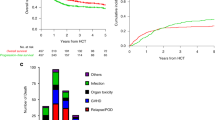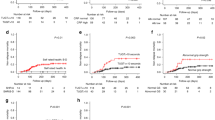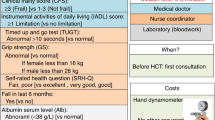Abstract
In a cohort of inpatient hematopoietic cell transplantation (HCT) recipients, we assessed patterns of referral to rehabilitation treatment, functional performance and short-term outcomes in patients who received post-transplant rehabilitation in comparison with those who did not. Among 201 first-time HCT recipients, 53 (26%) were referred to an inpatient rehabilitation provider, had an assessment of functional performance using the Functional Independence Measure scale and underwent rehabilitation treatments to address functional needs. Patients who received rehabilitation therapy were more likely to be females (P=0.02), older than 60 years of age (P=0.0146), employed (P=0.01), have hypertension (P=0.02), peripheral vascular disease (P=0.01) and pre-transplant Karnofsky Performance Score (KPS) <90 (P=0.02). Mean functional performance scores for transfers and ambulation increased significantly in the group with rehabilitation interventions (P=0.0022 and P<0.0001, respectively). There was no difference between the groups that did and did not receive rehabilitation treatments in 30-day re-admission rates. Patients who are 60 years of age or older, with pre-transplant KPS<90, and pre-transplant hypertension were more likely to be referred for rehabilitation treatments in the early period after HCT. Future studies should be designed to determine the optimal timing and cost effectiveness of functional assessment and rehabilitation treatments in this high-risk population.
This is a preview of subscription content, access via your institution
Access options
Subscribe to this journal
Receive 12 print issues and online access
$259.00 per year
only $21.58 per issue
Buy this article
- Purchase on Springer Link
- Instant access to full article PDF
Prices may be subject to local taxes which are calculated during checkout

Similar content being viewed by others
References
Pasquini MWZ . Current use and outcome of hematopoietic stem cell transplantation: CIBMTR summary slides 2011.
Cheville AL, Beck LA, Petersen TL, Marks RS, Gamble GL . The detection and treatment of cancer-related functional problems in an outpatient setting. Support Care Cancer 2009; 17: 61–67.
Hwang SS, Chang VT, Cogswell J, Alejandro Y, Osenenko P, Morales E et al. Study of unmet needs in symptomatic veterans with advanced cancer: incidence, independent predictors and unmet needs outcome model. J Pain Symptom Manage 2004; 28: 421–432.
Thorsen L, Gjerset GM, Loge JH, Kiserud CE, Skovlund E, Flotten T et al. Cancer patients' needs for rehabilitation services. Acta Oncologica 2011; 50: 212–222.
Holmes MD, Chen WY, Feskanich D, Kroenke CH, Colditz GA . Physical activity and survival after breast cancer diagnosis. JAMA 2005; 293: 2479–2486.
McTiernan A, Irwin M, Vongruenigen V . Weight, physical activity, diet, and prognosis in breast and gynecologic cancers. J Clin Oncol 2010; 28: 4074–4080.
Denlinger CS, Engstrom PF . Colorectal cancer survivorship: movement matters. Cancer Prev Res (Phila) 2011; 4: 502–511.
Ruden E, Reardon DA, Coan AD, Herndon JE 2nd, Hornsby WE, West M et al. Exercise behavior, functional capacity, and survival in adults with malignant recurrent glioma. J Clin Oncol 2011; 29: 2918–2923.
Jones LW . Physical activity and lung cancer survivorship. Recent Results Cancer Res 2011; 186: 255–274.
Jones LW, Hornsby WE, Goetzinger A, Forbes LM, Sherrard EL, Quist M et al. Prognostic significance of functional capacity and exercise behavior in patients with metastatic non-small cell lung cancer. Lung cancer 2012; 76: 248–252.
McQuellon RP, Russell GB, Rambo TD, Craven BL, Radford J, Perry JJ et al. Quality of life and psychological distress of bone marrow transplant recipients: the 'time trajectory' to recovery over the first year. Bone Marrow Transplant 1998; 21: 477–486.
Takekiyo T, Dozono K, Mitsuishi T, Murayama Y, Maeda A, Nakano N et al. Effect of exercise therapy on muscle mass and physical functioning in patients undergoing allogeneic hematopoietic stem cell transplantation. Support Care Cancer 2015; 23: 985–992.
Lee SJ, Fairclough D, Parsons SK, Soiffer RJ, Fisher DC, Schlossman RL et al. Recovery after stem-cell transplantation for hematologic diseases. J Clin Oncol 2001; 19: 242–252.
Artz AS, Pollyea DA, Kocherginsky M, Stock W, Rich E, Odenike O et al. Performance status and comorbidity predict transplant-related mortality after allogeneic hematopoietic cell transplantation. Biol Blood Marrow Transplant 2006; 12: 954–964.
Deschler B, Binek K, Ihorst G, Marks R, Wasch R, Bertz H et al. Prognostic factor and quality of life analysis in 160 patients aged>or =60 years with hematologic neoplasias treated with allogeneic hematopoietic cell transplantation. Biol Blood Marrow Transplant 2010; 16: 967–975.
DeFor TE, Burns LJ, Gold EM, Weisdorf DJ . A randomized trial of the effect of a walking regimen on the functional status of 100 adult allogeneic donor hematopoietic cell transplant patients. Biol Blood Marrow Transplant 2007; 13: 948–955.
Dimeo F, Bertz H, Finke J, Fetscher S, Mertelsmann R, Keul J . An aerobic exercise program for patients with haematological malignancies after bone marrow transplantation. Bone Marrow Transplant 1996; 18: 1157–1160.
van Haren IE, Timmerman H, Potting CM, Blijlevens NM, Staal JB, Nijhuis-van der Sanden MW . Physical exercise for patients undergoing hematopoietic stem cell transplantation: systematic review and meta-analyses of randomized controlled trials. Phys Ther 2013; 93: 514–528.
Morishita S, Kaida K, Setogawa K, Kajihara K, Ishii S, Ikegame K et al. Safety and feasibility of physical therapy in cytopenic patients during allogeneic haematopoietic stem cell transplantation. Eur J Cancer Care (Engl) 2013; 22: 289–299.
Persoon S, Kersten MJ, van der Weiden K, Buffart LM, Nollet F, Brug J et al. Effects of exercise in patients treated with stem cell transplantation for a hematologic malignancy: a systematic review and meta-analysis. Cancer Treat Rev 2013; 39: 682–690.
Keith RA, Granger CV, Hamilton BB, Sherwin FS . The functional independence measure: a new tool for rehabilitation. Adv Clin Rehabil 1987; 1: 6–18.
Guilfoyle R, Demers A, Bredeson C, Richardson E, Rubinger M, Szwajcer D et al. Performance status, but not the hematopoietic cell transplantation comorbidity index (HCT-CI), predicts mortality at a Canadian transplant center. Bone Marrow Transplant 2009; 43: 133–139.
Saad A, Mahindra A, Zhang MJ, Zhong X, Costa LJ, Dispenzieri A et al. Hematopoietic cell transplant comorbidity index is predictive of survival after autologous hematopoietic cell transplantation in multiple myeloma. Biol Blood Marrow Transplant 2014; 20: 402–408 e401.
Author information
Authors and Affiliations
Corresponding author
Ethics declarations
Competing interests
Dr DA has the following disclosures: This publication was supported by the National Center for Research Resources and the National Center for Advancing Translational Sciences, National Institutes of Health, through Grant Number 8UL1TR000055. Its contents are solely the responsibility of the authors and do not necessarily represent the official views of the NIH.
Dr ESM has the following disclosures: This publication was supported by the National Center for Research Resources and the National Center for Advancing Translational Sciences, National Institutes of Health, through Grant Number 8UL1TR000055. Its contents are solely the responsibility of the authors and do not necessarily represent the official views of the NIH.
The remaining authors declare no conflict of interest.
Rights and permissions
About this article
Cite this article
Laine, J., D’Souza, A., Siddiqui, S. et al. Rehabilitation referrals and outcomes in the early period after hematopoietic cell transplantation. Bone Marrow Transplant 50, 1352–1357 (2015). https://doi.org/10.1038/bmt.2015.141
Received:
Revised:
Accepted:
Published:
Issue Date:
DOI: https://doi.org/10.1038/bmt.2015.141



